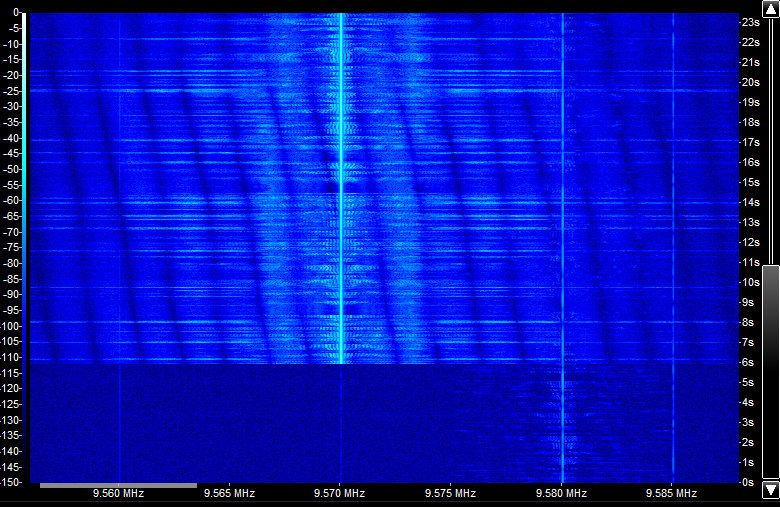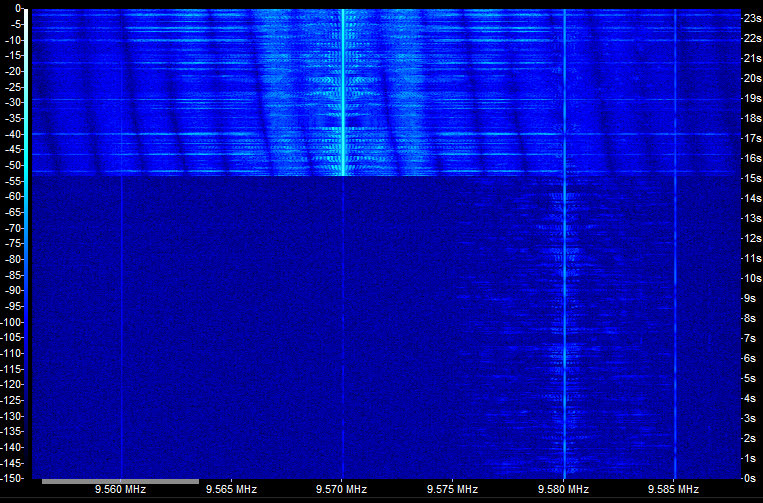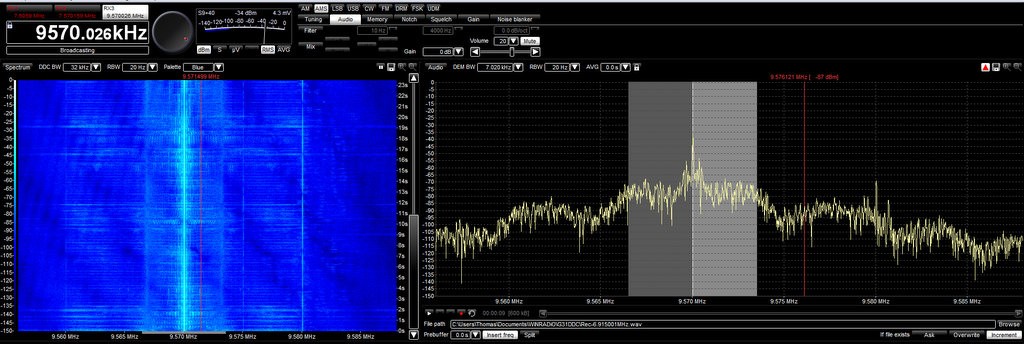China Radio International via Radio Havana Cuba
Each morning, I enjoy listening to Radio Australia on 9,580 kHz, but I’m forced to tune elsewhere due to interference when China Radio International starts broadcasting on 9,570 kHz, via Radio Havana Cuba’s relay.
Hypothetically I should be able to mitigate any adjacent interference from CRI by listening to Radio Australia’s upper sideband. But unfortunately, RHC’s transmitters spew spurious emissions a full 20 kHz on either side of their carrier. It’s most annoying.
Here’s what RHC/CRI’s 9570 kHz signal sounds like on 9560 kHz:
Here’s what my waterfall looked like when CRI signed off:
 Notice how clear the 35 kHz waterfall window became (that’s Radio Australia centered on 9850 kHz):
Notice how clear the 35 kHz waterfall window became (that’s Radio Australia centered on 9850 kHz):
The reason for this is clear: obviously, some of RHC’s transmitters are in need of care–and they’re not the only ones.
Radio Cairo
I’ve received a number of requests from Radio Cairo to post notices about their English language broadcasts. Normally, I’m quite happy to post press releases, but in each case I’ve mentioned that their English broadcasts are almost impossible to understand. For years, RC has had a problem with AM modulation (I assume) and, to my knowledge, have never addressed it.
I’ve sent RC feedback on a number of occasions; in response, I’ve received only the inconclusive reply that they’re “looking into the situation.”
To underscore the point, on Sunday Andrea Borgnino shared the following video/audio of Radio Cairo via Twitter.
Radio Cairo & worst am modulation @SWLingDotCom @LondonShortwave @John_Northants @UlisK3LU pic.twitter.com/o0aRCkPtwt
— Andrea Borgnino IW0HK (@aborgnino) March 20, 2016
There are other broadcasters that emit messy signals, but Radio Havana Cuba and Radio Cairo are the most noticeable in my listening area. And, it seems, neither broadcaster is in any hurry to address their ongoing problems.
In Radio Cairo’s case, especially, the broadcaster is simply wasting money by attempting to broadcast a signal that can neither be received nor interpreted. It’s rather sad. Ultimately, one has to wonder why they bother to broadcast at all…
Radio Havana Cuba, China Radio International, and Radio Cairo (among others) take note: a little care of your radio transmitters will go a long way toward increasing your listenership.
What you can do: Consider contacting broadcasters when when you become aware of transmitter problems. Despite RC’s notable exception, oftentimes a broadcaster may not be fully aware of the issue––thus your feedback is necessary to help correct the problem.


I thought I had a parasitic in my local oscillator but that was the only frequency I heard it on
Its interesting I “ain’t” the only one who gets slammed by the Cuban 300kw relay for China. I enjoy ABC in morning and their signals usually are 20 plus db over the 9 mark. But the minute Cuba comes in forget it.
Also Cairo is a joke. Why waste the energy on such a sick transmitter?
Cairo had actually gotten worse in the last few weeks… See here:
https://youtu.be/hbAhoEvIouk
Whatever transmits around 1700 UTC on 12075 kHz belongs into that “pain in the shortwave’s arse” category as well. Trying to hear Radio Australia on 12065 kHz doesn’t even work in ECSS/LSB anymore because whatever that is on 12075 (my list says it’s the BBC but I can’t believe that) is badly overmodulated and sends 30khz wide clipping spikes into the band. 🙁 Can someone verify what that asinine broadcaster is on 12075? I’d like to send them some ummm love.
all these shortwave broadcasters would do better if they operated their gear like the pirates do.
Agree. When a ham goes on the air, the common courtesy is to first find out if the frequency is in use, or QSY to a vacant space.
Except for contest weekends (which seems to be every weekend nowadays) when every band is populated in several layers and everyone yells at anyone else that he had this frequency for hours, followed by lots of four- and five-letter ham spirit. 🙂
It used to be only field day CQ and 73 magazine had contests. You would zero beat and tune up on Radio Moscow now every ham club and their grandma have their own contests every weekend
Radio Cairo has had the low modulation problem for ever. When I began DXing back in the late 60s I logged them and sent a report. I was 13 years old and can still recall explaining to them. ” You seem to have a good signal here but the announcer isn’t talking loud enough.” It mistifies me too how an international broadcaster could make this mistake for decades.
R. Cairo Facebook page contains links to podcast items:
https://www.facebook.com/Radio-Cairo-to-North-America-531239993558433/
The programs are probably recorded from satellite. The sound quality is better than in shortwave, nice to listen despite some background noise. You can find other similar recordings from http://radio360.eu/
I share the frustration of hearing these broadcasters, and just within the last week or so I’ve noticed the Caribbean Beacon broadcasts are sounding like Radio Cairo as well. I fear that as shortwave becomes less and less relevant, we’ll hear more transmitters left to die a slow, noisy death on air.
What’s really surprised me is that CRI seems to be one of the better broadcasters out there as far as paying attention to transmissions and sound quality, but their Havana relay is pitiful. Some of the programs relayed via the Cerrik transmitter site are quite noisy as well, although I suspect it’s being sent to Cerrik that way. Other broadcasts from that relay are usually pretty clear.
In 2012 Radio Cairo contacted me asking what I thought of their programs. As I pointed out they had a number of programs.
Their main target for English on SW is areas with the smallest number of listeners. They only have one transmission targeted towards Asia. Which is for Indonesia, but as I pointed out there signal is so bad. It isn’t even audible in Indonesia.
Who is their audience? They didn’t even know. They are continuing in languages that are not really needed. A former staff from the German Section told me that in the 6 years he spent in the language section. They would get fewer than 30 letters and emails a month from Germany. he also told me Italian, Spanish, and Russian were the same. French had a better response, but from Africa only.
They needed to find out new means of distribution. Is there a easy to find website? What is their mandate? If it’s informing those outside of Egypt about the country they are doing a terrible job.
And most importantly what everyone points out. They have terrible SW audio.
Radio Cairo is just like many of the European stations after 1991. Technology changed, but they didn’t
Why not send them s QSL card with your spectrum picture on the back side giving a signal including your side band splatter observation. Let’s see what kind of response (if any) they reply.
Good idea, though I seriously doubt they’ll pay attention. I actually hope this post does! 🙂
Cheers,
Thos.
Well if enough do it they’ll take notice. If they were in the US, a complaint to the FCC will get things done.
An FCC complaint wouldn’t get anywhere. The FCC doesn’t get involved know audio quality complaints
Not so much audio quality but sideband splatter and spurious out of band signals. You can have lousy audio but that is different than emissions outside of assigned channel. Radio hams cannot get away with it,
They don’t get involved in interference to splatter from HD interfering with other stations(aka WBZ 1030 HD interfering with WYSL 1040 analog)
The FCC approved (or NRSC-5) as the HD standard. That is a standards oversight that may end up in litigation but as it appears now, Both WBZ and WYSL are complaint in their licensing. WBZ is 50kw and WYSL is 20/13.2/0.5kw station. Sounds like an unanticipated standards screwup resulting in an unfortunate situation. As a practical matter I can hear WLW in Cincinnati, 700 Khz 50kw dispute that WRKO 680 khz is 4 miles from me when nights are good for reception.
Let’s fix BRAZIL too?
Hey. At least it’s always easy to spot a Radio Cairo signal … You can tell right away from how bad it sounds!